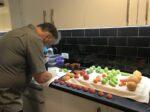Government and agricultural leaders gather at Parliament to celebrate 50 years of Fieldays
Town and country came together in New Zealand’s capital last night to mark the 50th anniversary of New Zealand Agricultural Fieldays, which was first held in Hamilton in 1969. Leaders from government, agriculture and business gathered in the Grand Hall in Wellington’s Parliament for the function, which included speeches from Director-General of Ministry for Primary Industries, Martyn Dunne, and New Zealand National Fieldays Society CEO Peter Nation. Fieldays is recognised as the largest agricultural event in the Southern Hemisphere. The official launch at Parliament is 90 days out from the 50th anniversary of Fieldays, which will be held 13-16 June at Mystery Creek near Hamilton. Mr Nation said it was an honour to be hosted at Parliament’s Grand Hall, which is a privilege only offered to non-profit organisations and community groups. “Parliament is the powerhouse of New Zealand, and the opportunity to have our 50th anniversary launch event there indicates the significance of Fieldays to the country,” said Mr Nation. “Fieldays is important to New Zealand’s primary industries. For 50 years we’ve been bringing urban and rural communities together and working to advance agriculture through technology, education, innovation and internationalisation.” The New Zealand National Fieldays Society board, and its president Peter Carr, also attended last night’s event, along with representatives from top New Zealand agricultural organisations and businesses. In addition, a large group of MPs attended, as well as senior officials from Ministry of Primary Industries and Callaghan Innovation, which demonstrated the strength of connections between Wellington and Mystery Creek, said Mr Nation. “We really value the support we’ve had over the years from local government and central government,” said Mr Nation. “Fieldays has always been a place that prime ministers and MPs have come to talk to farmers and take the pulse of the industry. Fieldays is a place […]










